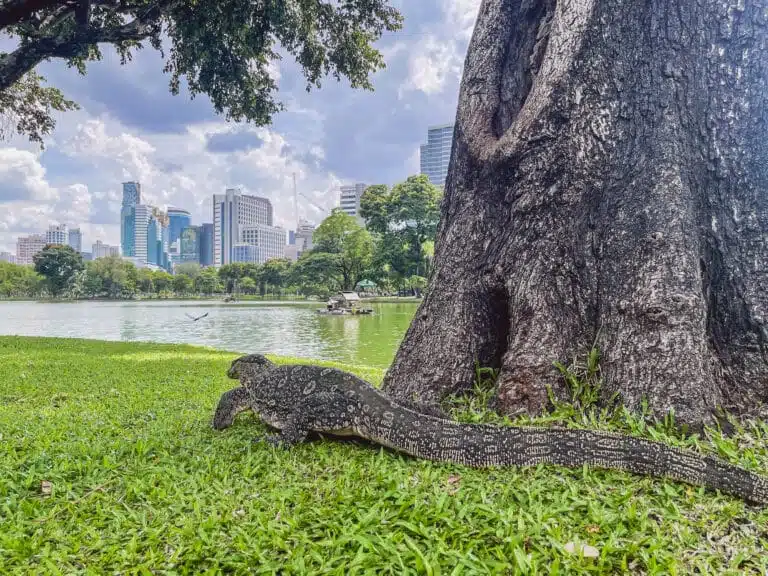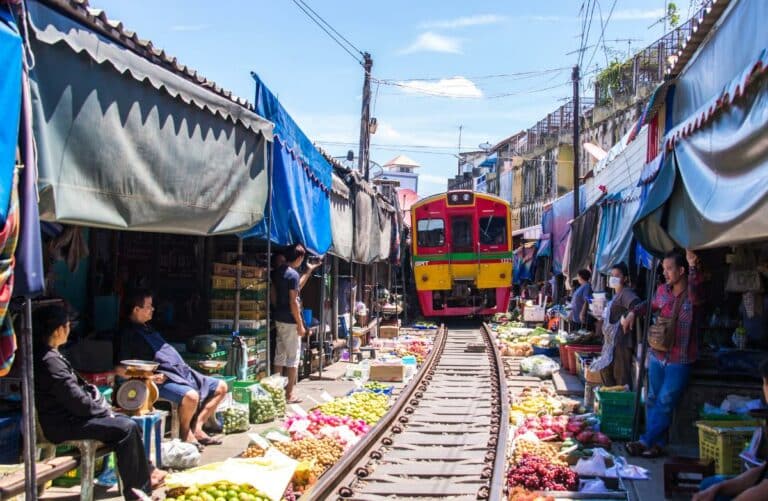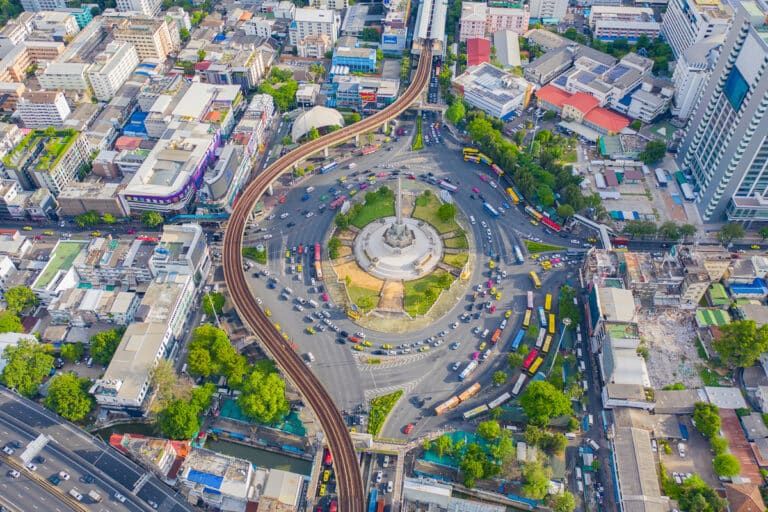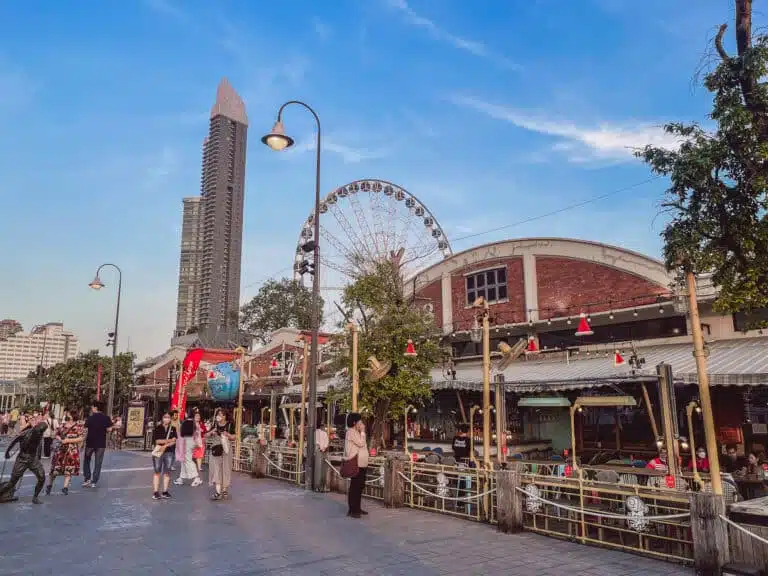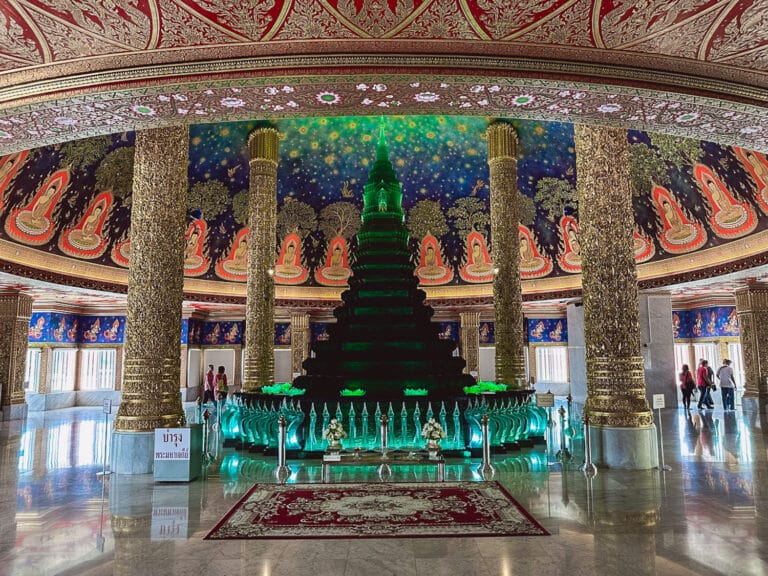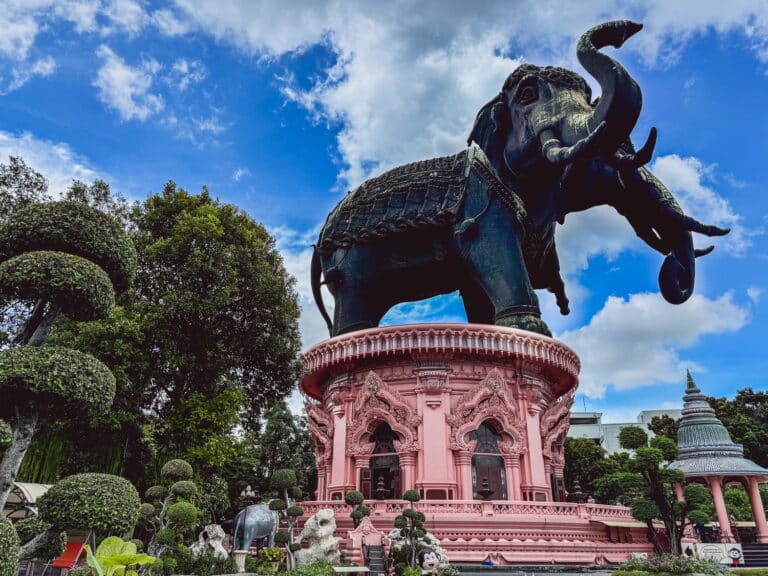Chinatown Bangkok: a trip to the district of contrasts
Thailand’s vibrant capital Bangkok is famous for its cultural treasures, which are particularly reflected in its many unique neighborhoods.
One of the most fascinating and lively neighborhoods is Chinatown, which is located in the Samphanthawong district in the heart of the city.
Chinatown Bangkok is a microcosm of cultures, a seemingly endless culinary treasure trove and a place where Thai history meets modern joie de vivre.
In this post, we take you on an exciting journey through the colorful and bustling Chinatown in Bangkok.
Here you can find out everything you need to know about its history, sights, cultural treasures and culinary highlights.
Tip: This guided tour through Chinatown shows you the most exciting corners of the district.

The eventful history of Chinatown Bangkok
The history of Chinatown Bangkok stretches far back into the past.
It began in the late 18th century when King Rama I encouraged Chinese from Fujian province to settle and trade in Bangkok.
The district grew steadily over the years and became a center for Chinese culture, commerce and community.
During the Second World War, Chinatown Bangkok experienced a dark phase when it was occupied by Japanese troops.
Nevertheless, the area recovered after the war and flourished again. Today, Chinatown is a lively and thriving district that offers a fascinating insight into Chinese culture and history.

The most important sights in Chinatown Bangkok
Chinatown is packed with highlights that make the district one of the most popular sights in Bangkok.
You should definitely not miss out on this during your visit:
1st Yaowarat Road
The approximately 1.5-kilometer-long Yaowarat Road is the heart of Chinatown and offers history, culture and culinary highlights.
Its history dates back to the 18th century, when Chinese immigrants settled here.
Today, Yaowarat Road is characterized by Chinese architecture, impressive temples and traditional stores selling Chinese medicine, handicrafts and much more.
The street is also a paradise for foodies, as you will find some of the best cookshops and food stalls in the city here.
Along Yaowarat Road, you can try classics such as fried noodles, dim sum, spring rolls and grilled seafood.
The street is also home to some great temples and shrines. The most famous is Wat Traimit, also known as the Golden Buddha Temple.
It is home to a massive golden Buddha statue, which is considered to be one of the largest in the world.
The Leng Noei Yi Temple is also known for its breathtaking architecture and centuries-old statues.
Yaowarat Road is also an absolute hotspot for shopping in Bangkok. Here you can find souvenirs, traditional Chinese products, handicrafts, tea, spices, herbal medicine and much more.
Last but not least, Yaowarat Road is also the venue for traditional Chinese festivals.
A highlight is the Chinese New Year festival – here you can experience street parades, dragon dances and fireworks.
Tip: This Bangkok street food tour takes you to Chinatown, where you’ll learn more about the neighborhood’s history and food scene from your local guide.


2. chinatown gate
The Chinatown Gate, also known as “Odeon Circle”, is an impressive architectural landmark that marks the entrance to Chinatown Bangkok.
The majestic gate rises proudly above Yaowarat Road and is a symbol of the rich Chinese culture and history that is deeply rooted in the area.
The Chinatown Gate was built in 1999 to mark the 72nd birthday of King Bhumibol Adulyadej and is a great example of traditional Chinese architecture.
The red roof and golden decorations are particularly eye-catching. The color red symbolizes luck and prosperity in Chinese culture, while gold represents wealth and success.
The Chinatown Gate often serves as a starting point for guided tours and as a meeting point for locals.
The gate is particularly beautiful at night when it is illuminated and bathes Chinatown Bangkok in a wonderful light.
Tip: Here we show you the best night markets in Bangkok.

3rd Wat Traimit (Golden Buddha Temple)
Wat Traimit, also known as the Temple of the Golden Buddha, is one of the most fascinating religious and cultural landmarks in Bangkok.
The Buddhist temple is home to one of the largest Buddha statues in the world, a massive golden Buddha statue known as Phra Phuttha Maha Suwana Patimakon.
What makes Wat Traimit so special is the extraordinary history of the Buddha statue. It was originally made of plaster and covered with stucco to protect it from theft.
For many centuries, people were unaware that a valuable gold statue was hidden beneath the plain outer layer.
It was not until 1955, when part of the plaster covering was damaged in an accident, that the monks discovered the golden treasure underneath.
The statue weighs an impressive 5.5 tons and is made of almost 100 percent pure gold. Their value is inestimable, both materially and spiritually.
Wat Traimit has therefore become an important pilgrimage site that attracts believers from all over the world.
Tip: Experience the real Chinatown on this tour. Discover hidden corners, temples and a cool café in the company of a knowledgeable guide.

4th Wat Mangkon Kamalawat
Wat Mangkon Kamalawat, also known as the “Dragon Temple”, is an impressive religious and cultural landmark in Bangkok.
The Buddhist temple is located in the heart of Chinatown Bangkok and is an important center for the Chinese community in the city.
What makes Wat Mangkon Kamalawat so unique is its impressive dragon arch at the entrance, which symbolizes luck and prosperity.
The colorful arch is not only a work of art, but also one of the most popular photo spots in Bangkok.
But the interior of the temple is also rich in Chinese Buddhist symbolism and is home to impressive statues and altars.
Wat Mangkon Kamalawat shines in all its glory, especially during the Chinese New Year (Songkran).
It is then a popular pilgrimage site for believers who pray here, perform rituals and ask for the blessing of the gods.

5th Crocodile Temple (Wat Chakrawat)
The Crocodile Temple, or Wat Chakrawat, is a very special Buddhist temple in Bangkok.
What makes the temple so special are its unusual inhabitants: crocodiles. The temple is actually home to some crocodiles that live in a pond on the temple grounds.
The history of the Crocodile Temple goes back a long way and is shrouded in legends and stories.
A Buddhist monk is said to have founded the temple many decades ago and began taking in injured or orphaned crocodiles.
Over time, these crocodiles became an unusual attraction at the temple.
Visitors to the crocodile temple can observe the crocodiles from a safe distance, as access to them is restricted.
The temple itself is a quiet and contemplative place that invites you to pray and meditate.
Tip: This guided tour through Chinatown shows you the most exciting corners of the district.
6th Sampeng Lane
Sampeng Lane, also known as Soi Wanit 1, is a bustling street in the heart of Chinatown Bangkok.
The narrow alleyways offer a fascinating insight into the local culture and trade in the district.
Sampeng Lane stretches for several blocks and is lined with countless stalls and stores selling everything from clothes and jewelry to household goods and souvenirs.
Apart from shopping, Sampeng Lane also offers the opportunity to sample regional delicacies and street food.
The cookshops and food stalls along the street offer a variety of dishes, from fried noodles to fresh fruit.
Tip: Sampeng Lane in Chinatown is best visited in the morning. Most stores are open from 8:00 am to 6:00 pm.
Tip: You should definitely visit these brilliant cafés in Bangkok.

7th Sala Chalermkrung Royal Theatre
The Sala Chalermkrung Royal Theatre in Bangkok is a historical landmark and an important venue for Thai culture and art.
Originally built in 1933, it was established by King Rama VII and served as a platform for performances, shows and events.
The theater was built in an architectural style that is a mixture of Western and Thai elements.
It has been renovated and modernized over the years, but its original charm has been retained.
Today, the theater is an important cultural venue in Bangkok and attracts both locals and tourists who want to experience the country’s traditional art and culture.
Every Thursday and Friday, locals and visitors can enjoy theater performances, classical Thai dance, concerts and other cultural events.

8. the Chinese cemetery
The Chinese cemetery, also known as the Bangkok Christian Cemetery, is a historical and cultural gem in Bangkok’s Chinatown.
The cemetery was founded in the 19th century and served as a final resting place for people of different ethnic and religious backgrounds, including Chinese, European and Thai communities.
What makes the Chinese Cemetery so special are the elaborately designed graves and monuments that can be found here.
The gravestones are often decorated with elaborate inscriptions and symbols that tell the history and stories of the deceased.
Tip: Experience the real Chinatown on this tour. Discover hidden corners, temples and a cool café in the company of a knowledgeable guide.
9th Flower Market
The Flower Market in Bangkok, also known as “Pak Khlong Talat”, is a colorful and bustling market dedicated to the flower and plant industry.
The Flower Market stretches along the canal and is open day and night as the flower and plant deliveries arrive continuously from different parts of the country.
An incredible variety of flowers, plants and wreaths await you here, from exotic orchids to fragrant jasmine blossoms.
Among other things, the market is an important center for traditional Thai flower crafts.
The traders arrange elaborate bouquets and wreaths for religious ceremonies, weddings and other festive occasions.
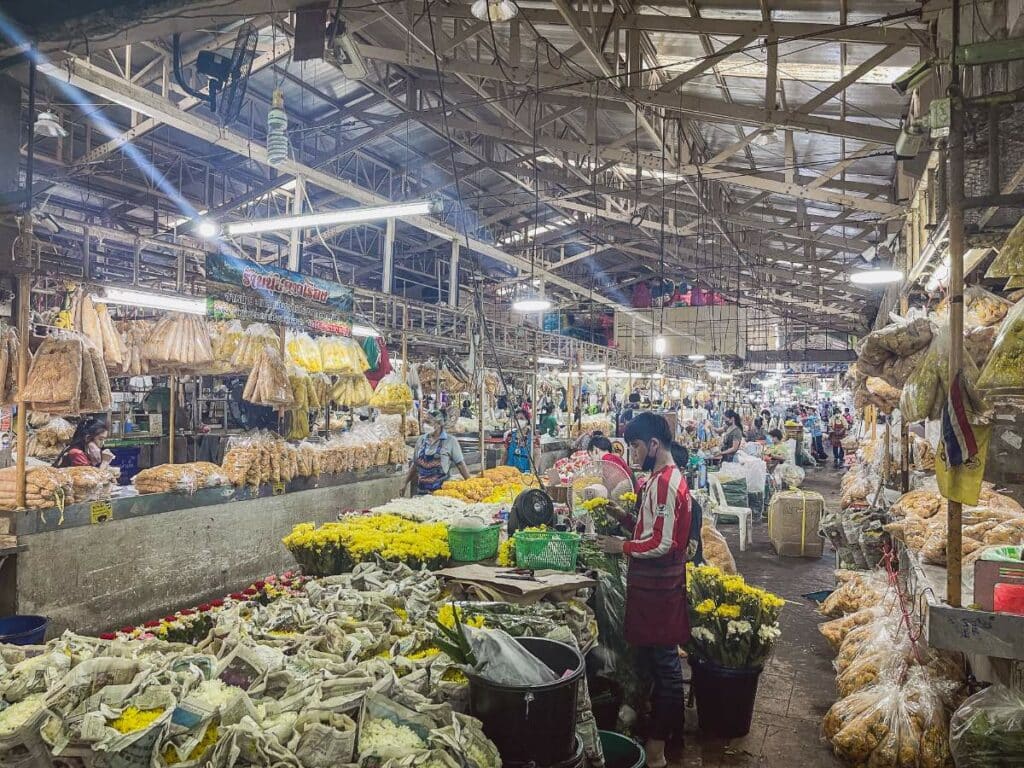

10. street art in Chinatown Bangkok
The street art scene in Chinatown Bangkok is an up-and-coming and fascinating facet of the historic district.
In recent years, regional and international artists have transformed the streets and alleyways of Chinatown into a canvas for their creative ideas.
The most striking feature of the street art in Chinatown is the great murals and graffiti that adorn the buildings.
The artworks range from lifelike portraits to abstract designs and often tell stories about the history and culture of the neighborhood.
Another interesting aspect of street art in Chinatown are the sculptures that pop up in various places.
They are often made from recycled materials and contribute to the unique aesthetic of the neighborhood.
The street art in Chinatown has not only helped to beautify the neighborhood, but has also created a vibrant art scene that appeals to both locals and tourists.
The artists use this platform to address social and cultural issues and keep the diversity and spirit of Chinatown alive.
Tip: Explore Bangkok’s creative scene on this street art e-scooter tour through Chinatown!

11th street food in Chinatown Bangkok
Street food in Chinatown Bangkok is a feast for the senses and a culinary adventure that captures the essence of the vibrant neighborhood.
The narrow streets of Chinatown are lined with cookshops and food stalls offering a tempting variety of savory dishes and sweet snacks.
Here you can enjoy authentic Thai street food at its best.
From fried noodles and steamed dim sum to fresh seafood and exotic Thai desserts – the choice is virtually endless.
And best of all, the Thai specialties in Chinatown are not only delicious, but also very affordable.
The best times to experience street food in Chinatown are in the evening and at night, when the alleyways come to life and the cookshops prepare their fresh dishes.


Tip: This Bangkok street food tour takes you to Chinatown, where you’ll learn more about the neighborhood’s history and food scene from your local guide.
Besides delicious snacks like fish balls with noodles or fried dough sticks, you will also discover sights like Wat Mangkon.
Frequently asked questions about Chinatown Bangkok
Here we answer some frequently asked questions about Chinatown Bangkok.
How do I get to Chinatown Bangkok?
Chinatown is located in the heart of Bangkok and stretches along Yaowarat Road. You can reach the district by MRT (Hua Lamphong station), cab or boat.
Why is Chinatown also called “Yaowarat”?
The name “Yaowarat” comes from the original Chinese term “Yao Wa Rat”, which means “precious stone” or “jewel”. The name reflects the historical importance of the district for trade.
What culinary highlights are there in Chinatown Bangkok?
Chinatown is known for its fantastic street food, including fried noodles, dim sum, Peking duck, fresh seafood and exotic desserts such as durian sticky rice.
Which stores and markets can be found in Chinatown?
In Chinatown you will find countless stores ranging from goldsmiths and herbal pharmacies to souvenir stores. Sampeng Lane Market is also a popular place for shopping.
Is Chinatown a safe place for tourists?
Yes, Chinatown is safe for tourists. However, as in all busy places, you should keep an eye on your valuables.
When is the best time to visit Chinatown Bangkok?
The best time to visit Chinatown Bangkok is in the evening and at night, when the food stalls and restaurants are open and the district comes to life even more.


